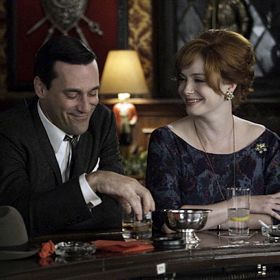Times They Are A-Changin' In 'Mad Men' Season Five DVD

5/5
Matthew Weiner’s wildly successful Mad Men, the AMC series that pays homage to America’s dystopian past, provides a welcome departure from the seeming onslaught of programs that wallow in its dystopian future—be it zombie-infested, alien-invaded or just plain temporally displaced. With Mad Men, fans can enjoy all the same lost idealism while referencing their history books or, more likely, poring over Wikipedia in a “second-screen experience” dedicated to the backdrop of the show.
Take season five of Mad Men, now available on DVD just in time to pave the way for the penultimate season six launch on April 7, 2013. Historical backdrop is one of numerous things Mad Men does better in season five than it arguably ever has (no small accomplishment), incorporating events like the 1966 summer riots and the Richard Speck nurse murders into the very fabric of its storyline in meaningful ways that surpass the conventional newspaper-headline shot.
In Mad Men, key events that have forged history actually affect our heroes and heroines right where they sit, as (gasp!) current events do with us every day in our real lives (think water-cooler talk). This includes everything from Michael Ginsberg (newcomer Ben Feldman) accusing his fellow creatives of being “excited” over images of “some girl trussed up like a cut of meat,” to Peggy Olson (Elisabeth Moss) sticking her foot in her mouth when she mistakes Dawn Chambers’ (Teyonah Parris) fear of racial violence for that of isolated mass murder, naively quipping, “You’re not a nurse” when Dawn admits that she won’t take the subway to Harlem late at night.
However, like most things in the world of Mad Men, the constant attention to social back story is operating on another level entirely. In the past, the writers have mainly used history to show off their attention to detail, but now the portrayal of the changing American '60s is starting to take on a revolutionary gravity that complements the flavor of the era and whistles an ominous out-with-the-old tune. There's an entire episode ("At the Codfish Ball") about children disappointing their parents, and vice-versa. Edging their way into key scenes are openly gay characters (a far cry from the season three downfall of Sal Romano) and African-American white-collar workers (oh my!).
Season five shows us, better than any before it, that times, they really are a’changin’, and the new generations—represented by fledglings Megan Draper (Jessica Pare), Ginsberg, Sally (Kiernan Shipka), Glen (Marten Holden Weiner), and even ol’ mainstay Peggy (who, not coincidently, is the oldest of the “progressive” generation and also faces the most external and internal conflict about her shift into modernity)—are poised to take over, intensifying the gradual sense of displacement that characters like Bertram Cooper (Robert Morse), Betty Draper (January Jones), Lane Pryce (Jared Harris), and even foils Joan Harris (Christina Hendricks) and Don Draper (Jon Hamm) are about to experience.
Price guarantees in one of the season’s most harrowing episodes, “Commissions and Fees,” that he won't be on the proverbial train that's leaving the station, while Cooper subtly reveals in the finale, “The Phantom,” that his contribution to board meetings has essentially devolved to reminding the new secretary that “there should be danish.”
You might point out that no one ever expected Cooper or the button-up Price to usher in the new world, but is it really fair to lump Don and Joan in with the dinosaurs? Sure, Don may feel a little confused when he tries to tap into the minds of teenage Rolling Stone groupies in “Tea Leaves” (the first episode in the series directed by Hamm), but his bewilderment tends to border on distress. After all, Don has been positioned as the quintessential man of his time, so without his time, where is he? Hung up on trifles like Cooper? Throwing in the towel like Price?
Probably not. The gut reaction suggests that we needn’t worry our pretty little heads about Don, who has always found a way to reinvent himself when the goin’ gets tough, even if his transformations feel more like a coward’s kneejerk reactions than a brave man’s industrious adaptations. And if any of us were still unsure of how the consummate ad guy would restore his pride after feeling temporarily displaced, we are assured by the final scene of the season, when Don greets his Cinderella-clad wife on the set of the shoe commercial he got her, takes one lingering look back at her on the cusp of the burgeoning career he helped secure, and walks decisively away as the theme to James Bond’s You Only Live Twice (a film that premiered two days after the season five finale of Mad Men was meant to take place) punctuates his dramatic departure. Cut to a bar scene, a lit cigarette, a blonde, a brunette, an indecent proposal, and Don Draper is well on his way to his … what does this make, fourth? … life. Bond, it seems, has got nothing on Draper. So the likes of Megan and Peggy can have their new world — Don will just undoubtedly find a way to obtrusively insert himself here and there as an oh-so-irresistible anachronism.
But what about Joan? Didn’t Joan, after all, make partner at Sterling Cooper Draper Price a mere months after she kicked her callow husband to the curb (with the poetic, “I’m glad the army makes you feel like a man, because I’m sick of trying to do it.”)? Indeed, and while Joan has made admirable strides in her time, her victories belong to it — not the era that Peggy and Megan are busy building from scraps. Sure, Joan does things on her terms, even when she is being manipulated by the likes of Pete Campbell (Vincent Kartheiser), Price, and, most blatantly of all, Don, in the episode “The Other Woman” (one of the best things to ever happen to Mad Men — or possibly television — despite an occasional tilt toward the heavy-handed), but the control that she exerts over her environment stops with exactly that — her environment — just as it does with Don.
It is for this reason, among others, that Joan and Don — not Peggy and Don, as was, perhaps, once the case — have become foils of one another. Both are ultimately victims of their time, despite ruling their respective roosts; both are preternaturally savvy businesspeople; both willingly opted for divorce while other unhappy couples forged ahead; both use their sexuality as either a tool or weapon when love just isn’t available; both accepted a long time ago that the world may be a game, but it is an unhappy game — a lesson someone like hapless Campbell is trying very hard not to learn. The conclusion is, of course, that two people so dependent on their placement in mid-twentieth century America can’t be entirely the same when one is a man and one is a woman. Even so, it’s no coincidence that the relationship between Joan and Don is one of mutual respect that is not based on sexual distractions. Joan, in fact, sometimes seems like the only kid on the block who doesn’t make him the object of her daddy complex.
Which brings us to Peggy. While Peggy is the last person who should get short shrift, she is the only one who seems able to speak for herself, metaphorically and literally. When it occurs to Peggy that people like Ken (Aaron Staton) might be moving on with their lives, she wastes no time finding a new place for herself and severing those pesky emotional ties she still has to Don in a matter-of-fact fashion, as if she's checking off a to-do list. Peggy may not be the perfect girlfriend or even the perfect copywriter, but she is the perfect self-promoter, once she swallows the realization that no one will look out for her but herself. Take that, Heinz.
While the characters that loom large on the inside cover of the Mad Men Season Five DVD set may be the squeaky wheels, the show is an ensemble effort if there ever was one. The most bit player creates ripples that affect all the characters, and everyone’s particular relationship to everyone else, no matter how seemingly insignificant, is explored, leaving nothing to chance or neglect, which makes the show feel almost magical next to most television endeavors that largely follow the “uh … we never got around to writing that backstory” rule book.
With the Season Five DVD, you also get a smattering of special features that might feel like a bit of a letdown after the brilliance of the show. These include a collection of the characters’ finest one-liners, an exploration of some of the show’s marketing and artwork, a quick bartending lesson sponsored by Canadian Club (ostensibly the most popular whiskey of the Mad Men era), a glimpse into the score, and audio commentaries from Weiner and the cast for each episode. But, most importantly, you get to have each brilliant episode from the hands-down best season of Mad Men at your disposal, wherein you’re guaranteed to notice something new every time you watch, even if it’s nothing more than a hilarious quip from Roger Sterling (John Slattery), who may not get the best storylines, but shoulders an easy three-quarters of the show’s comic relief all on his own.
For all its ironies and with all its ambiguous (or outright morally deplorable) characters, Mad Men does something that no other series on television can claim: it absolutely refuses to pander. The writing neither takes you in the direction you thought you were going, nor tries to surprise you by turning the opposite way. The storylines flow naturally out of the characters’ motivations, and sometimes things you simply can’t control — things that no one would have ever suspected — get in the way of your plans. But that’s just life in the big city, on Madison Avenue.
RELATED ARTICLES
Get the most-revealing celebrity conversations with the uInterview podcast!







Leave a comment